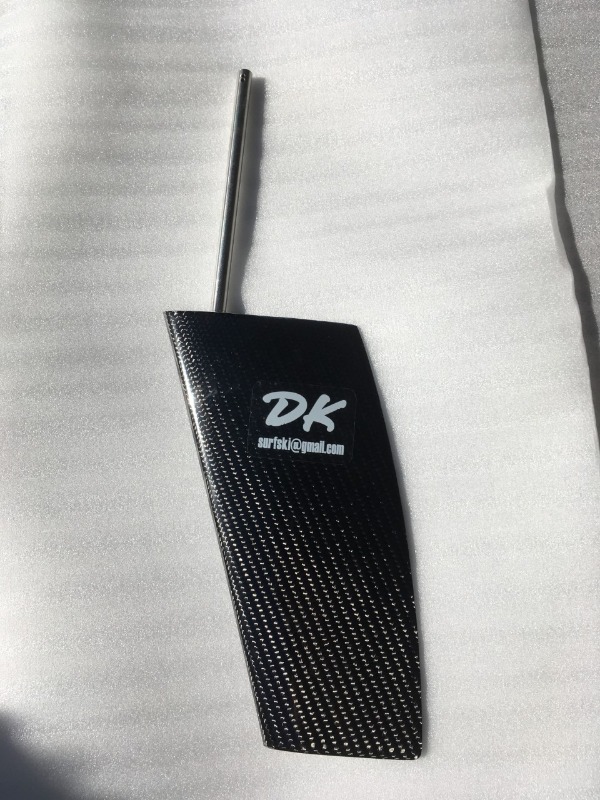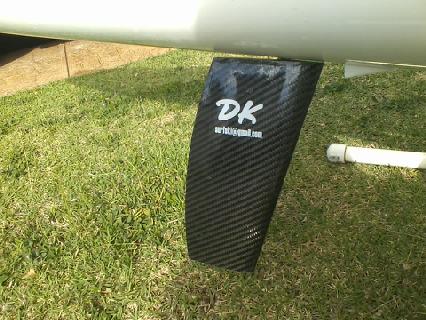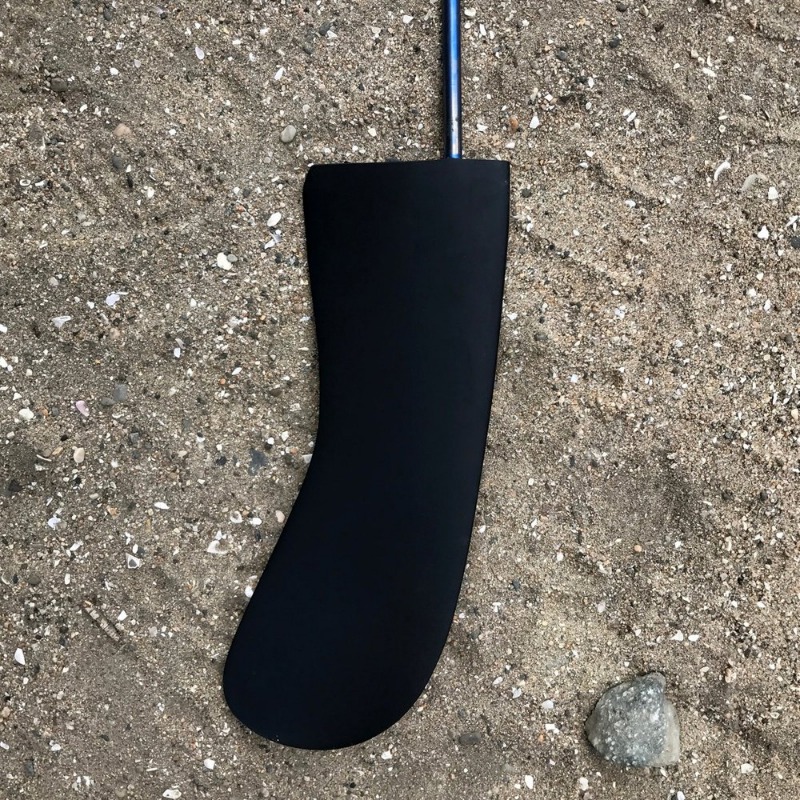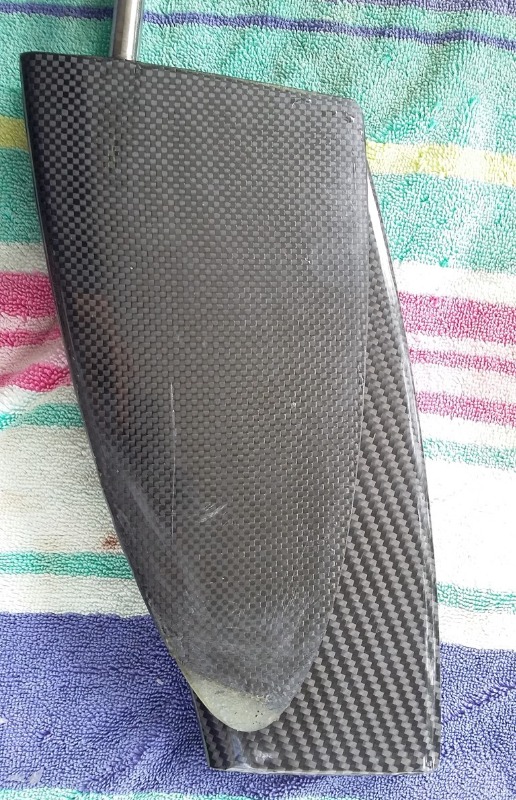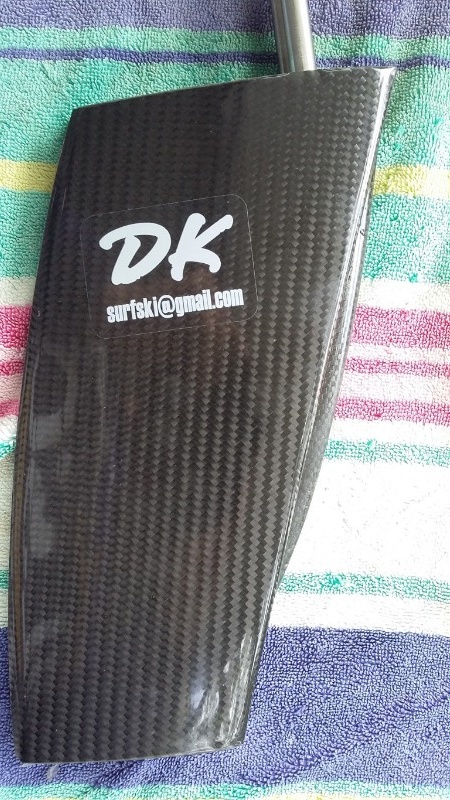- Posts: 16
- Thank you received: 3
How big of a Rudder?
- MCImes
- Topic Author
- Visitor
Im going to get a DK rudder for my new Swordfish S. Im considering the 'standard 20 degree' rudder either 9.0" or 9.5" (maybe 10") (22.8 or 24.1cm) long in either the regular or high chord version (either 110mm top 80mm bottom 'regular' depth or 120mm top 90mm bottom "high chord" depth)
Im in southern, California - We typically get 0.5 to 2.0m 12+ second long period swell, 10-20kt winds that produce 0.5 to 1.25m wind waves at 4-9 seconds. Typically swell and wind are offset by 5-30 degrees.
My goal is to have a very responsive boat that can go to a hole quickly, resist broaching in short, steep chop, but at the same time not introduce a ton of roll or unnecessary drag. I currently have the Fenn large elliptical rudder and its good, but I want more broach-resistance and fast response to catch a hole
Have any thoughts about longer vs shorter or high chord vs regular? Is there such a thing as too much rudder? how do you tell where that is?
Thank you much!
Please Log in or Create an account to join the conversation.
Cheers, Dave
Current boat: Fenn Swordfish S (Hybrid layup).
Previous boats: Epic V8 (Performance layup), Stella SR (Excel layup).
Location: Sydney, Australia.
"The sea lives in every one of us" - Robert Wyland.
Please Log in or Create an account to join the conversation.
FENN Bluefin S
FENN Swordfish S carbon hybrid
Epic V8 double gen 2
Lot and lots of DK rudders.
Had:
Stellar SEL excel (gen 2)
Stellar SR excel (gen2)
Stellar S18s g1 (excel)
Epic V10 Double (performance)
Stellar SR (gen 1)
V10 sport (gen 2)
V10 (Gen 2)
Beater SEL (gen 1)
Please Log in or Create an account to join the conversation.
In downwind you won't be bothered if there is a little extra drag but I really don't think there is much if any compared to the stock Fenn rudder as my pace on flat water has not changed.
The torque created is noticeable but seems to be something you get used to. I'd get advice from DK re how much it differs with chord and angle. For length I can't imagine how more than 9" would be necessary with a DK shape.
CrabStick, Perth Western Australia
Current Boats: Epic V9 ultra, Fenn Swordfish S, Fenn Spark S
Previous: Think Eze, Stellar SR, Carbonology Boost LV, Fenn BlueFin S
Please Log in or Create an account to join the conversation.
- MCImes
- Topic Author
- Visitor
I did a little cardboard layout to compare the options. 9" is way longer and has much more surface area at the bottom compared to the elliptical. I definitely dont need longer than 9". Now my only debate is regular or high chord. I'm sure I would be happy with either. so far we have one vote for regular and one for high.
Is there a good/comprehensive article on rudders? I am curious how Angle of Attack, Length, Chord (and maybe chord to thickness aspect ration) all play into feel and performance
Like, Low angle of attack = more aggressive turning, less resistance on the pedals, less self-correcting action when no steering is applied
Longer = more roll, better handling at the crest of a wave
High chord = more turning power without introducing as much roll as adding length
something like that but more in depth and from someone much more expert than me! (im not even sure if those statements are correct so remember what you paid for it
Decent points about technique as well. The SF is the first boat I've had that turns quickly and finds a hole nicely, so I am definitely still learning the finer points of downwind, but have never come close to thinking "My rudder is too big"
Please Log in or Create an account to join the conversation.
Attachments:
Please Log in or Create an account to join the conversation.
Sweep/rake: Less sweep (more vertical) rudders are more responsive and powerful, requiring smaller pedal input for effect. More sweep is more forgiving, so if you have a hull that is very easy to turn like the SF, you may find that really low angle of sweep is too reactive/twitchy and the boat whips around when you don't expect it. The lowest sweep I've seen on ski rudders is about 10-15% although some OC1 downwind rudders are almost vertical. You used the term "angle of attack" when describing this parameter, which may confuse people since AOA refers to the angle at which the chord line intercepts the medium. So for us, if the rudder is perfectly in line with the hull and pedals even, AOA is zero.
Depth: The major consideration is whether or not you have enough depth to keep adequate surface area in the water when the boat is nose down on a bump. Steep short wavelength needs a deeper rudder than longer/bigger swells since the tail of the boat breaks out the back and overhangs the water more in the short/steep stuff. I believe ellipticals are inferior because they don't have enough surface area at the tip of the rudder, which often is the only part of the rudder in contact with the water when you are nose down on a steep short bump.
Chord length: Longer chord for a given depth obviously is more surface area and powerful. But it also is my understanding that a longer chord is able to handle a higher AOA before stalling. If you imagine laminar flow of water wrapping around a rudder with, say, 20 degrees AOA, a shorter chord length forces the water flow to make tighter sharper turns, so it's more likely to lose that smooth flow, create turbulence and lose lift/ power/ and stall. The downside is for a given depth, you have more surface area therefore more drag with higher chord, assuming laminar flow. But if you are stalling, then that creates tons of drag in addition to the fact that you can't steer, and will broach.
Foil thickness: This is what people are talking about when they refer to "NACA" foils. Basically, how wide of a hole in the water is created when the rudder passes through? Relatively thin foils have less drag but require more speed for the same amount of turning power. So airplanes (or America's cup catamarans) that go really fast have razor sharp wing foils and slow Cessnas etc. have chubby fat foils. So a good designer will take into account the speed of the craft when selecting the foil thickness.
In my case, I asked Don for a rudder that had the necessary depth/surface area at the tip to handle big hawaii downwind, and also very resistant to stalling. The Ion has relatively stiff handling so it needs a fair amount of rudder power to hold a diagonal once you've committed to dropping down the face when making connections. This is what I got:
And it's great. 9 inch depth, 15 degree sweep. Actually looks pretty similar to Pete's "reef buster" with mine having a bit more chord. Although it is optimized for downwind control, I'm not able to measure any speed difference in the flat compared to the stock 7 inch.
I recommend going my route and just asking for the qualities you want, based on the conditions you paddle in and your skill/ style, and just see what shows up in the mail!
-Patrick
Please Log in or Create an account to join the conversation.
Please Log in or Create an account to join the conversation.
- MCImes
- Topic Author
- Visitor
I pulled the trigger on the 9" 20° High Chord. Cant wait to try it out in a week or 2!
Just a shout out to Don as well. he was extremely helpful through the whole process. Great customer service from him.
Please Log in or Create an account to join the conversation.
THat's a grip rudder from Puakea designs (for OC1's). 10.5" long. The "grip" part is to reduce drag. See store.puakeadesigns.com/product/the-grip-rudder
Attachments:
Please Log in or Create an account to join the conversation.
Please Log in or Create an account to join the conversation.
Please Log in or Create an account to join the conversation.
- uk gearmuncher
- Visitor
Please Log in or Create an account to join the conversation.
Please Log in or Create an account to join the conversation.
- MCImes
- Topic Author
- Visitor
Wow, huge improvement. small pedal inputs result in very fast response. the stability of the boat is increased. even when pushed into a hard turn I think the rudder induced roll is manageable and better than spending a lot of time parallel to the waves when turning around because the rudder roll is more predictable than beam waves. no noticeable increase in flat water resistance. much less stall (due to the fatter cross section?). razor sharp trailing edge. good workmanship all around. fit my boat perfectly with one Teflon washer at the top and bottom.
The funnest part of the night was sitting just outside the jetty and surfing bigger sets in. Although the swell was very small in deep water, it was ~15 second period so it stacked up slowly and big. small sets were ~2ft breaking with standouts nearly double that. with the Stellar stock rudder, the fenn shark fin, and the fenn elliptical rudder i would broach even on smallish waves. the DK 9" high chord held an amazing line. I surfed the swell for about 100m until about 15m before the wave went critical. I could easily hold a line, i did not broach once (even cresting the wave as it went under me and i was only 30* from parallel when it was nearly critical! amazing!). I couldn't quite pick wherever I wanted to go once I had a lot of speed and the wave was steep, but that is a big ask and unrealistic to expect as the wave gets steep and tall. it did keep the boat fully in control though, a first for me. ive never enjoyed surfing beach break because stock rudders seem to universally suck and would never have or hold a good line. now its actually very fun! I cant wait to try it in a proper downwind too.
My initial run with it still made me think maybe i should have gone for the 10" over the 9". when i was screaming down the face of the nearly critical wave i had good control and was fully broach proof, but still thought 11% more rudder would not hurt. I was afraid the rudder roll would be unmanageable so went with 9" instead of 10" but now have no concern. I guess my goal was to say to myself "ive finally done it - i have too much rudder and must contain my inputs". I think the 9" high chord is perfect, but not too much, and my subconscious goal was 'too much rudder'. Thats ok though, its an excellent rudder and a huge improvement. if i feel the same just before the gorge ill just get the 10" i suppose.
last thought - all stock rudders ive ever used are somewhere between junk and barely acceptable. elliptical is a junk shape. shark fin is a junk shape. as far as I'm concerned, all rudders should be a fat airfoil that is cutoff squarely at a length appropriate for your conditions. a consistent profile and large side area deep in the water is critical for steep and big wave control based on tonight's surfing.
Please Log in or Create an account to join the conversation.
Attachments:
Please Log in or Create an account to join the conversation.
- uk gearmuncher
- Visitor
Please Log in or Create an account to join the conversation.
Cheers, Dave
Current boat: Fenn Swordfish S (Hybrid layup).
Previous boats: Epic V8 (Performance layup), Stella SR (Excel layup).
Location: Sydney, Australia.
"The sea lives in every one of us" - Robert Wyland.
Please Log in or Create an account to join the conversation.
uk gearmuncher wrote: Most of the replies here relate to improving the behaviour of the boat on downwind. However, has anyone bought a new rudder with the aim of merely improving the boats stability a notch ?
I did exactly this on my Swordfish. Almost all of my paddling in the UAE is on flatwater and the boat was a equipped with a downwind rudder when I bought it new. The downwind rudder was OK but on flatwater it imparts a significant roll to the boat with large or fast rudder inputs.
I fitted the ski with a Fenn low profile rudder which has provided 2 benefits in that under rudder input there is less roll with the turning reaction being very direct, and the ski is measurably faster. In a straight line I feel no difference in stability between the two rudders.
Please Log in or Create an account to join the conversation.
- Hacker Mike
- Offline
- Senior Member
- Posts: 52
- Thank you received: 13
As background, I have been paddling surfski for about 4 yrs and paddle a Fenn Swordfish S in big downwind conditions and a Fenn Elite S in the smaller stuff. I have always used the standard issue Fenn rudder and must say that I have never has a problem with their rudders. The boats turn reasonably well and I very seldom have a problem with broaching (I don't recall broaching in the last yr or more).
After reading all the recent posts on the improvements in the boat by installing a bigger rudder, I installed the Orka Elliptical rudder on the SF and did two downwinds over the weekend in 30 knots with messy side swell. I found that the boat went from being very predictable and stable to being extremely twitchy and reacting aggressively (tipping) with the slightest rudder input. Needless to say, I have two of the slowest times I have had for a long time. That said, the boat did seem to track better when catching small bumps travelling diagonally to the main side swell, but it was marginally better, not significantly better.
I know that I should not come to any conclusions regarding the Elliptical rudder with only two paddles, but my initial reaction is that the Orka Elliptical is just too "aggressive" for me and that the negative of rudder induced twitchy out ways the positive of more manoeuvrability (which I didn't find a problem in the first place).
I hope to give a DK Rudder a go in the near future and see if that provides the additional manoeuvrability and stability without the rudder induced twitchyness that I experienced with the Elliptical.
Once again, thanks for the interesting discussion and points of view.
M
Please Log in or Create an account to join the conversation.
Latest Forum Topics
-
- Debrito bailer gasket replacement
- 2 days 1 hour ago
-
- Surfski Width x Length Chart
- 2 days 5 hours ago
-
- New Epic V10 - generation 4
- 4 days 16 hours ago


